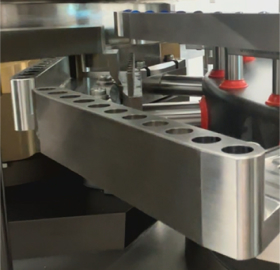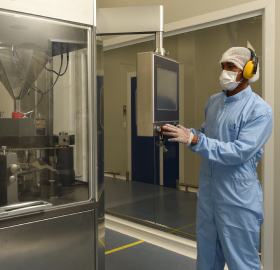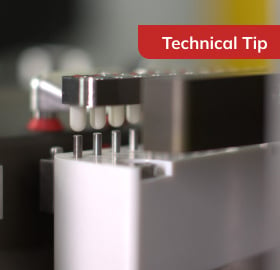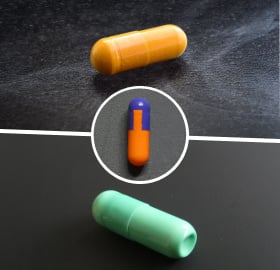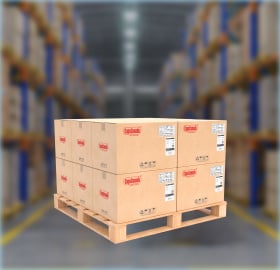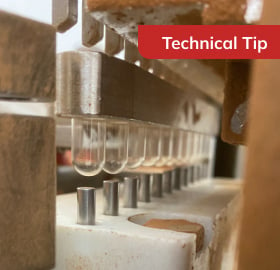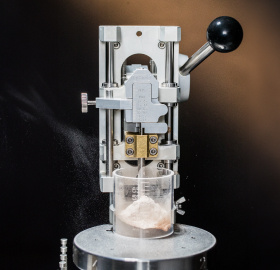Tamping style fillers, perhaps the most widely used filling machines, use a five-step compression process to achieve the final target weight. The critical machine components to keep an eye on include the tamping pins, the tamping springs, dosing disc and sealing plate. The purpose of tamping springs is to act as a relief during the compression process --they absorb pressure from the tamping pins as the tamper head descends. The amount of pressure needed to help with proper powder slug formation depends on the compressibility of the fill material. In any case, consider that in one eight-hour shift, tamping pins may go through the compression cycle as many as 60,000 times. It is advisable to check spring condition on a regular basis, as worn or broken springs will lead to product weight variation. As a general rule, when a spring measures 2mm shorter than a brand-new spring, it is time to replace.
Have you ever put your hand in a glove too quickly, and find that your fingers do not go into the holes in the glove just right? Tamping Pins and dosing disc work together like a hand-in-a-glove, but with a lot more speed, and a lot less forgiveness. Improper alignment between any one tamping pin and dosing disc will result in metal-to-metal contact, and damage to both parts. When these components are new, they are made with a mirror finish, and perfectly squared off leading edges.
The mirror finish protects against powder sticking to the machine parts, and the squared edges of pin and disc provide for even pressure, with no escape points for powder as the pin plunges into the disc bore. There are two very common reasons that tamping pins and disc become damaged. The first is because of improper alignment during set-up, and the second is because the bores of the guide ring are worn out, allowing for excessive side-to-side movement of tamping pins. Guard against weight variation by teaching proper set-up, and tooling handling techniques.
Dosator fillers are widely used in the nutraceutical and pharmaceutical industry. The equipment type is identified as a dosating machine because of the method of picking up powder into a tube for placement into the capsule. The dosator is comprised of two main parts; the dosator tube, and piston.
The function of the dosator assembly is to obtain powder of a consistent target weight from the powder bowl and transfer it to the capsule body. There are a couple of steps in the filling process. The dosator descends into the powder bed, and immediately following, the piston is pushed down through it to give pre-determined compression to the required dose.
The depth of the piston moving into the powder bed, and the amount of compression used are tools to obtain the correct amount of powder and form a good slug inside the dosator tube. An option for the equipment is an aspirating bowl to help with poorly compacting powders, providing a more uniform and dense powder bed.

Weight variation can occur due to damaged dosator tubes, and pistons. Some aggressive materials and fill volumes put excessive pressure on dosator tubes causing the metal to lose shape, becoming out of round. These should be inspected for roundness during each product set-up. The piston tips wear down over time from abrasive powders and should also be replaced periodically. Both the dosator tubes and pistons are commonly damaged through improper handling.
Keep learning about capsule technology trends...
- Gelatin capsules vs. HPMC capsules: What are the differences?
- Why Liquid-Filled Hard Capsules May Be a Better Option than Softgels
- Flavored capsules: the next customization level
Auger fillers, mostly found with semi-automatic capsule machines are known for their simplicity and versatility, being able to run most product types with good success, and output being the greatest drawback. Dosing occurs as product moves through the hopper, past a stir arm and into a vertical auger where pressure is built up between the auger, fill shoe, and capsule body ring.
If you are experiencing weight variation, ensure the auger is centered properly over the ring. This is best observed during set up, with the auger installed and the product hopper removed. Augers are available with different degrees of twist, which help with achieving varying product fill needs. The augers should be inspected for wear; as the ends become rounded, product is not pushed evenly into capsule bodies. Also ensure proper space between fill shoe and body ring, as it can result in weight variation.
For further troubleshooting in any part of the encapsulation process, please reach out to your local CapsCanada Technical Representative.



.jpg)


